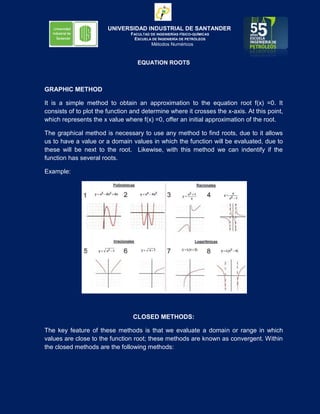Raices de ecuaciones
•Download as DOCX, PDF•
0 likes•188 views
Report
Share
Report
Share

Recommended
Recommended
More Related Content
More from marcelafernandagarzon
More from marcelafernandagarzon (6)
Series contribution to the numerical approximations

Series contribution to the numerical approximations
Recently uploaded
Recently uploaded (20)
Strategies for Landing an Oracle DBA Job as a Fresher

Strategies for Landing an Oracle DBA Job as a Fresher
Boost Fertility New Invention Ups Success Rates.pdf

Boost Fertility New Invention Ups Success Rates.pdf
Web Form Automation for Bonterra Impact Management (fka Social Solutions Apri...

Web Form Automation for Bonterra Impact Management (fka Social Solutions Apri...
Cloud Frontiers: A Deep Dive into Serverless Spatial Data and FME

Cloud Frontiers: A Deep Dive into Serverless Spatial Data and FME
2024: Domino Containers - The Next Step. News from the Domino Container commu...

2024: Domino Containers - The Next Step. News from the Domino Container commu...
Connector Corner: Accelerate revenue generation using UiPath API-centric busi...

Connector Corner: Accelerate revenue generation using UiPath API-centric busi...
ProductAnonymous-April2024-WinProductDiscovery-MelissaKlemke

ProductAnonymous-April2024-WinProductDiscovery-MelissaKlemke
Axa Assurance Maroc - Insurer Innovation Award 2024

Axa Assurance Maroc - Insurer Innovation Award 2024
Emergent Methods: Multi-lingual narrative tracking in the news - real-time ex...

Emergent Methods: Multi-lingual narrative tracking in the news - real-time ex...
Automating Google Workspace (GWS) & more with Apps Script

Automating Google Workspace (GWS) & more with Apps Script
Powerful Google developer tools for immediate impact! (2023-24 C)

Powerful Google developer tools for immediate impact! (2023-24 C)
Mastering MySQL Database Architecture: Deep Dive into MySQL Shell and MySQL R...

Mastering MySQL Database Architecture: Deep Dive into MySQL Shell and MySQL R...
Why Teams call analytics are critical to your entire business

Why Teams call analytics are critical to your entire business
Apidays Singapore 2024 - Scalable LLM APIs for AI and Generative AI Applicati...

Apidays Singapore 2024 - Scalable LLM APIs for AI and Generative AI Applicati...
Raices de ecuaciones
- 1. EQUATION ROOTS<br />GRAPHIC METHOD<br />It is a simple method to obtain an approximation to the equation root f(x) =0. It consists of to plot the function and determine where it crosses the x-axis. At this point, which represents the x value where f(x) =0, offer an initial approximation of the root.<br />The graphical method is necessary to use any method to find roots, due to it allows us to have a value or a domain values in which the function will be evaluated, due to these will be next to the root. Likewise, with this method we can indentify if the function has several roots.<br />Example:<br />CLOSED METHODS:<br />The key feature of these methods is that we evaluate a domain or range in which values are close to the function root; these methods are known as convergent. Within the closed methods are the following methods:<br />BISECTION (Also called Bolzano method):<br />The method feature lie in look for an interval where the function changes its sign when is analyzed. The location of the sign change gets more accurately by dividing the interval in a defined amount of sub-intervals. Each of this sub intervals are evaluated to find the sign change. The approximation to the root improves according to the sub-intervals are getting smaller.<br />THE PROCEDURE IS THE FOLLOWING:<br />1. Verify if Bolzano method is satisfied: f (a) • f (b) <0<br />2. Xr - ((b-a) / 2) + a, ie, midpoint<br />3. Make the following test:<br />If (f (xr) • f (a) <0)! b = xr<br />If not, (f (Xr) • f (b) <0)! a = Xr<br />if not, Xr = root<br />Repeated until Xr is the root.<br />The maximum number of iterations to obtain the root value is given by the following equation:<br />nmáx=1ln(2)a-bTOL<br />TOL = Tolerance<br />THE METHOD OF FALSE POSITION<br />Although the bisection method is technically valid to determine roots, its focus is relatively inefficient. Therefore this method is an improved alternative based on an idea for a more efficient approach to the root.<br />This method raises draw a straight line joining the two interval points (x, y) and (x1, y1), the cut generated by the x-axis allows greater approximation to the root.<br />Using similar triangles, the intersection can be calculated as follows:<br />F(X1)Xr-Xi=F(X2)Xr-X2<br />The final equation for False position method is:<br />Xr=Xu-FX2(X1-X2)FX1-F(X2)<br />The calculation of the root Xr requires replacing one of the other two values so that they always have opposite signs, what leads these two points always enclose the root.<br />Note: Sometimes, depending on the function, this method works poorly, while the bisection method leads better approximations.<br />Open method:<br />These methods are based on formulas that require a single value x or a couple of them but do not necessarily contain the root, because this feature sometimes these methods diverge or move away from the root that grows half the number of iterations. It is important to know that when the open methods converge are more efficient than methods that use ranges.<br />Open methods are:<br />Newton Raphson Method<br />The most widely used formula to find roots, is the Newton Raphson, argues that if it indicates the inicial value of x1 as the value of the root, then, then you can extend a tangent from the point (x1, f (x1) .) Where this line crosses the x-axis point of approach will be improved.<br />This method could result in a graph or series of Taylor.<br />Newton Raphson formula:<br />f'Xi=fXi-0Xi-Xi+1<br />This is obtained by reorder, the value of the desired root.<br />Xi+1=Xi-fXif'Xi+1<br />Note: The Newton Raphson method has a strong issue for its implementation, this is due to drift, as in some functions to evaluate the derivative is extremely difficult<br />Secant method<br />The secant method allows an approximation of the derivative by a divided difference, this method avoids falling into the Newton Raphson problem as it applies for all functions regardless of whether they have difficulty in evaluating its derivative.<br />The approximation of the derivative is obtained as follows<br />f'(xi)≅fxi+1-f(xi)xi+1-xi<br />Substituting this equation in the Newton Raphson formula we get:<br />Xi+1=Xi-fXi(xi+1-xi)fxi+1-f(xi)<br />The above equation is the formula of the secant<br />